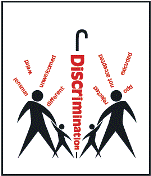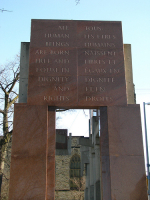2008: Celebrating the 60th Anniversary of the Universal Declaration of Human Rights
Universal Declaration of Human Rights: Introduction
Sixty years ago, nations of the world joined together in recognizing that all peoples, in all nations, are free and equal regardless of race, religion, economic status, age, gender or other personal characteristics. Through the signing of the Universal Declaration of Human Rights in 1948, the United Nations brought into being the first international document recognizing human rights as the foundation of peace, justice and freedom in the world.

The Universal Declaration outlines 30 basic rights essential for all human beings to achieve their full potential and to live a life free of fear and want. It was a unique approach that developed from the world saying 'never again' to the horrific events of World War Two, a war that brought a scale of atrocity never previously witnessed. The global death count is estimated to have been more than 50 million. War crimes were widespread: from the infamous Holocaust in which Nazi Germany sought to eliminate 'undesirables' such as Jews, Poles, Slavs, Roma, Sinti, the mentally and physically disabled, homosexuals and other persons, to the use of sex slaves, otherwise known as 'comfort women', by Japanese soldiers. Labour camps were used throughout the world and, disturbingly, World War Two brought the first testing of biological warfare by Japan and the use of atomic bombs in Nagasaki and Hiroshima by the United States of America. Read more...
Discrimination

In an increasingly globalized world, the diversity of people of differing colour, culture and creed represents a tapestry of world views and approaches to life. In this world of diversity, we all have a unique identity comprised of language, culture, belief, music, food and dress. Despite such differences, the Universal Declaration is built on the principle that ALL peoples are equal in human dignity and that everyone is equally entitled to all rights and freedoms "without distinction of any kind, such as race, colour, sex, language, religion, political or other opinion, national or social origin, property, birth or other status." This core principle of the Declaration embraces the value of difference and assumes that prejudice, discrimination and injustice often stem from the fear of the 'other'; those who are different from us.
Today in Canada, our demographics are changing with increasing immigrant and refugee settlement, declining birth rates of the Caucasian Canadian-born majority, and high birth rates among Aboriginal populations. Between 1996 and 2001 for example, the Métis population increased by 43%. We see an array of people who represent diverse faiths, racial and socio-economic backgrounds, sexual orientations and abilities. Yet within our daily lives, there is still evidence of discrimination and injustice against those that are "perceived" as different. When a mother doesn't receive the same salary as her male colleague; when a classmate is bullied at school because he is gay; when foreign-born, highly qualified neighbours cannot find jobs in keeping with their qualifications, or when a grandfather cannot take the bus because he is in a wheelchair; discrimination exists. Such lack of inclusiveness or discrimination in our communities violates human rights.
Discrimination can have detrimental impacts on people by excluding them from full integration and participation in their communities. It can also affect their ability to obtain a job, access some services and participate in public events and culture. Persons with disabilities are sometimes unable to access public places; persons of differing sexual orientations may feel forced to hide for fear of violence and bullying; racialized persons face slurs, profiling and hate. The impact of discrimination is that the people who are discriminated against rarely feel free to be themselves, and ultimately, their right to human dignity, which is the essence of the Universal Declaration, is compromised, affecting their self-confidence, well-being and quality of life. Society in general suffers when discrimination and prejudice exist. The emotional impact of ongoing systemic discrimination can lead to increased domestic and gang violence as well as substance abuse, and people becoming afraid to interact with others of different backgrounds.
We have the right to be ourselves and to embrace our individuality, but we also have the responsibility to respect difference and consider the values and experiences of other people. Treating others with respect - as you would expect to be treated - is at the core of human rights and is the basis for each of us to contribute to a world of peace and justice.
Canada's Charter of Rights and Freedoms, part of its Constitution, guarantees certain rights and freedoms to everyone in Canada, including democratic rights, mobility rights, legal rights, equality rights and language rights. All other laws and actions by governments in Canada are subject to the principles laid out in the Charter.
Human rights laws in all the provinces and territories of Canada, as well as in the federal jurisdiction, give individuals the right to be protected from discrimination and harassment where they work, live and do business. Such legislation also provides a system for redress when people's access to this right is limited or denied by government, businesses and organizations, or other individuals. The goal of these laws is the same as that of the Declaration: "faith in fundamental human rights, in the dignity and worth of the human person and in the equal rights of men and women … to promote social progress and better standards of life".
Learn More! Get Involved!
- Amnesty International: Stolen Sisters
- Canadian Association for Mental Health
- Department of Canadian Heritage
- CBC – Discrimination Gone Down in Canada
- Justice for Youth
Federal Provincial Human Rights Legislation
- Canada
- Alberta
- Manitoba
- New Brunswick
- Newfoundland and Labrador
- Northwest Territories
- Nova Scotia
- Ontario
- Prince Edward Island
- Quebec
- Saskatchewan
- Yukon
Related International Human Rights Documents
- Equal Remuneration Convention, 1951
- Convention on the Political Rights of Women, 1953
- Discrimination (Employment and Occupation) Convention, 1958
- Convention Against Discrimination in Education, 1960
- Convention on the Elimination of All Forms of Racial Discrimination, 1966
- International Covenant on Economic, Social and Cultural Rights, 1966
- Declaration on the Protection of All Persons From Being Subjected to Torture and Other Cruel, Inhuman, or Degrading Treatment or Punishment, 1975
- Declaration on the Rights of Disabled Persons, 1975
- UNESCO Declaration on Race and Racial Prejudice, 1978
- Convention on the Elimination of All Forms of Discrimination against Women, 1979
- Declaration on the Elimination of All Forms of Intolerance and of Discrimination Based on Religion or Belief, 1981
- Convention on the Rights of the Child, 1989
- United Nations Principles for Older Persons, 1991
- Principles for the Protection of Persons with Mental Illness and the Improvement of Mental Health Care, 1991



